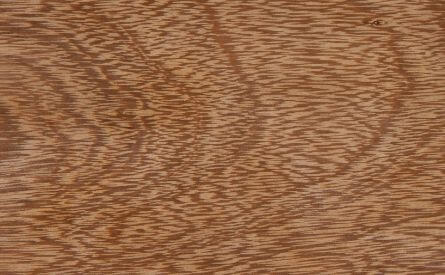Virola
Sangre / Virola koschnyi

Local Names
Banak, Bogabaní, Cedro Bastardo, Fruta Dorada, Manteco, Miguelarillo, Mollejo, Palo de Sangre, Sangre Real, Sangredrago, Sebo, Tabeque, Bicuiba, Cumala, Baboen, Camaticaro
Distribution & Tree
Virola is found across all of Central America and through northern South America. It is found in very humid and subtropical areas, particularly along the Atlantic coast. Sangre may reach a height of 40 m with trunk diameters of 120cm. Boles are heavily buttressed, cylindrical, and clear for more than two-thirds of total height.
Wood Appearance
As the wood dries, its heartwood becomes a pinkish golden-brown or deep reddish-brown. The sapwood, a lighter cream color, is not sharply demarcated. Its luster is low to medium with a coarse texture and straight grain.
Processing Properties
Works easily with both hand and machine tools and produces an excellent finish. It glues well and is easy to hammer. It cuts well into veneers and is easy to sand. It was good dimensional stability once properly dried. It has a low silica content around 0.11%. Its workability is similar to Spanish cedar and mahogany.
Strength & Durability
Sangre’s density and hardness are comparable to American elm, Mexican white cedar and Caribbean pine and it can readily be used for light construction. The wood is not resistant to decay and is susceptible to attack by termites and other insects. However, it’s easily treated.
Wood Uses
Sliced veneer and plywood, particle and fiberboard, furniture components, boxes and crates, light construction, general carpentry, interior paneling and other millwork. It is used for doors, windows, and moldings. Sangre can substitute okoume and iloma for plywood.
Ecological & Social Importance
Oil is extracted from seeds of virola for use in soaps and candles.
| Reference Species | ||||
| Technical Characteristics | Virola | Spanish Cedar | Big-Leaf Mahogany | |
| Density | kg/m3 | 544 | 448 | 560 |
| Janka Hardness | kgf | 377 | 184 | 456 |
| Bending Stiffness (Modulus of Elasticity) | GPa | 12.4 | 9.1 | 10.1 |
| Bending Strength (Modulus of Rupture) | MPa | 65.0 | 70.8 | 80.8 |
| Crushing Strength | MPa | 37.0 | 40.4 | 46.6 |
| Shrinkage, Radial | % | 5.4% | 4.1% | 2.9% |
| Shrinkage, Tangential | % | 9.4% | 6.2% | 4.3% |
| Shrinkage, Volumetric | % | 16.3% | 10.2% | 7.5% |
| T/R Ratio | 1.7 | 1.5 | 1.5 | |
| Values determined at 12% humidity | ||||
|---|---|---|---|---|
DENSITY
JANKA HARDNESS
BENDING STIFFNESS
BENDING STRENGTH
CRUSHING STRENGTH
SHRINKAGE
Values are for reference only and cannot be guaranteed. Wood is a natural material and physical and mechanical properties may vary depending on age, genetics, and other factors. We encourage customers to consult the references provided in the bibliography. For further explanations of wood’s key technical characteristics, an excellent resource is the Wood Database with articles on Density (average dried weight); Janka hardness; Elastic Modulus; Rupture Modulus; Crushing Strength; Radial, Tangential and Volumetric Shrinkage.






